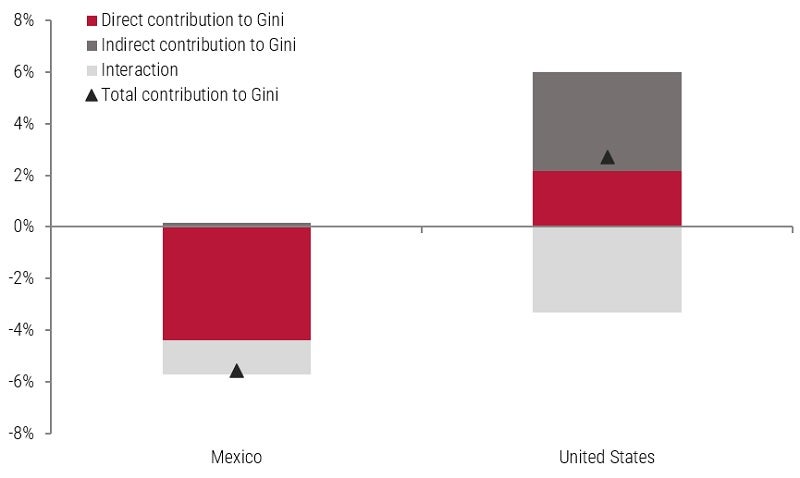
Does globalization increase or decrease inequality? That question has long been a topic of intense debate among economists and policymakers.
The roots of the debate stretch back two centuries, when British political economist David Ricardo proposed that nations that focus on their comparative advantage – by producing and exporting the products they can make most cheaply – will benefit the most from trade. Trade theory since then has emphasized the role of comparative advantage (that is, lower relative opportunity costs across countries) in shaping the specialization and division of labor within and among countries.
Then, in the 20th century, trade liberalization and new technologies accelerated global commerce. And the 1980s brought a new phase of globalization – the so-called second unbundling – when processes of production were pulled apart into a series of distinct, value- adding tasks that could be spread around the globe; in other words, global value chains (GVCs). So today, instead of specializing in final goods and services exports, countries participate in the global economy by trading tasks in which they have a comparative advantage. This process has opened up new opportunities for developing nations to participate in the global economy.
And yet, the emergence of GVCs has only intensified the debate about globalization and inequality. How does GVC participation contribute to wage inequality within nations? That is the subject of a new World Bank study, "The Role of Global Value Chains for Worker Tasks and Wage Inequality." It comes to some surprising conclusions.
In a typical GVC, low and middle-income economies with abundant labor but less advanced technology specialize in less demanding, more routine tasks that can be easily offshored – things like filling out forms and reading bills. High-income economies, on the other hand, tend to focus on non-routine tasks, such as solving problems, programming computers, and supervising employees – that are harder to offshore.
According to the study’s analysis, GVC participation is associated with reduced wages in offshorable occupations that involve routine tasks. At the same time, it is associated with higher wages in non-offshorable occupations – especially in services such as financial intermediation and business activities– that involve fewer routine tasks.
The study examines the level of routine-task intensity – the share of tasks that are repetitive, well-structured, and require being exact – across 38 countries at all stages of development. It shows that the greater a country’s participation in GVCs, the higher the routine-task intensity in jobs that can be offshored and lower the routine-task intensity in jobs that are harder to offshore.
Low- and middle-income countries tend to be destinations for offshored jobs with a high routine-task intensity. Mexico is typical of this pattern. Mexican industry specializes in assembling final products from prefabricated parts and manufacturing lower-value-added intermediates, such as assembling cars and related parts and accessories. These activities require more routine-intensive work, which tends to be outsourced from the United States and other advanced economies. This increases the share of routine-intensive jobs and tasks in Mexico.
What’s the impact on inequality? As you can see in the chart below, GVC participation increases the Gini coefficient in the United States and decreases it in Mexico (the higher the Gini coefficient, the more unequal the society).
GVC participation increases the Gini coefficient in the United States and decreases it in Mexico.

What is the mechanism at work here?
Participation in GVCs increases the routine-task intensity of offshorable jobs, while at the same time, reducing it in non-offshorable jobs. This widens inequality in both nations because more routine, repetitive tasks pay less. That is the indirect contribution of GVCs to inequality (dark grey bars). The indirect contribution to inequality seems to be weaker in emerging economies, possibly because they have fewer non-offshorable jobs.
GVCs also have a direct contribution to reducing inequality in emerging economies because they increase the number of offshored jobs there, which raises demand for workers and pushes wages higher.
In Mexico, this equalizing effect on wages (red bar) outweighs the indirect, disequalizing effect of the increase in the routine intensity of jobs. That pattern is typical for most countries studied that have become destinations for offshored jobs.
By contrast, in the United States, more routine-intensive work in offshorable occupations has reduced pay for workers at the lower end of the wage scale. On the other hand, wages of high-skilled workers in non-offshorable occupations have benefited the most from globalization. The study shows that this pattern is typical for developed countries that predominantly offshore jobs. So while GVC participation widened wage inequality by about 2 percentage points of the Gini coefficient in the United States, it reduced wage inequality in Mexico by 6 percentage points.
Put simply, the study found that GVC participation is associated with greater wage inequality in most high-income countries, but with reduced wage inequality in most low- and middle-income countries.




Join the Conversation